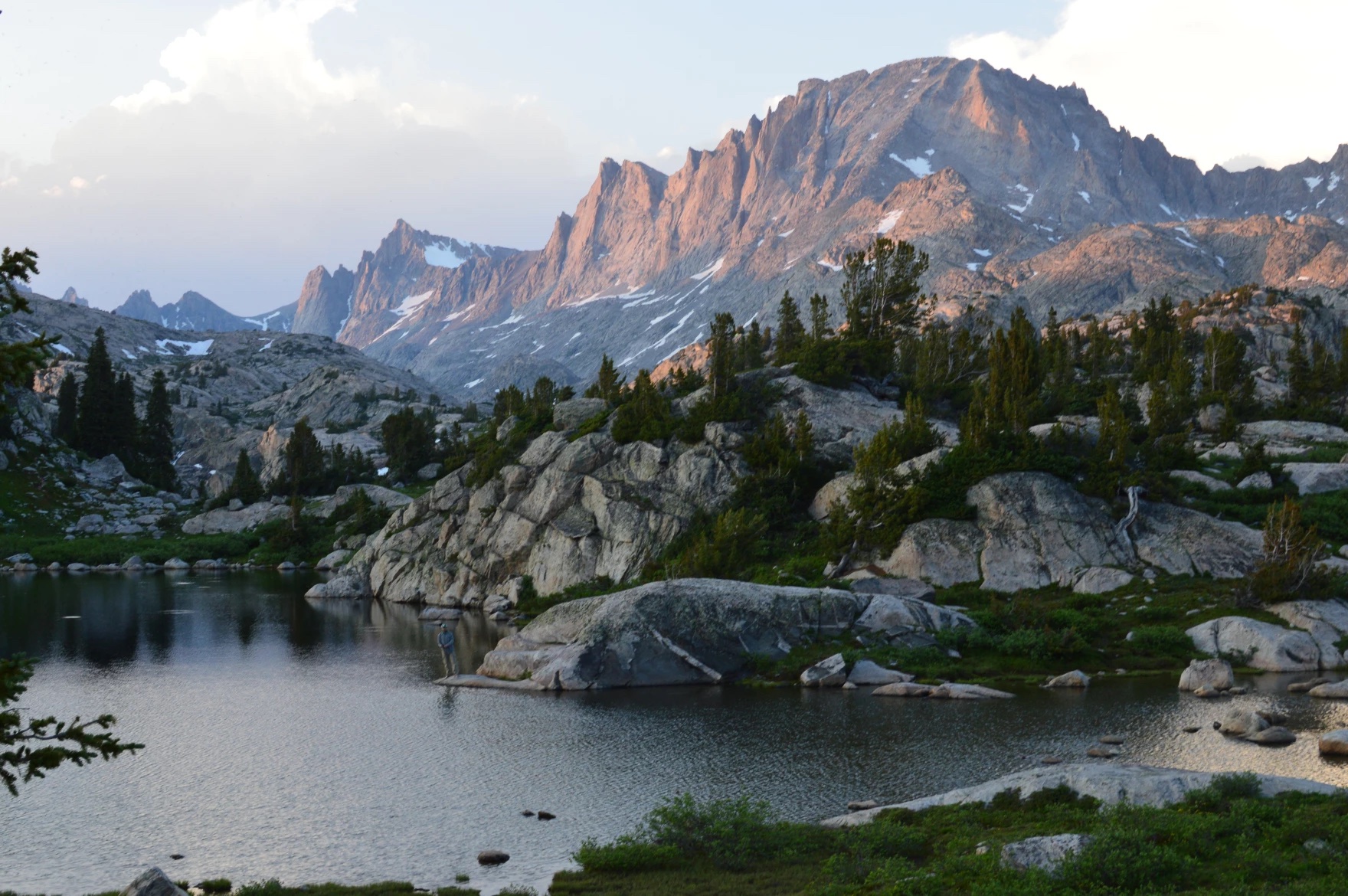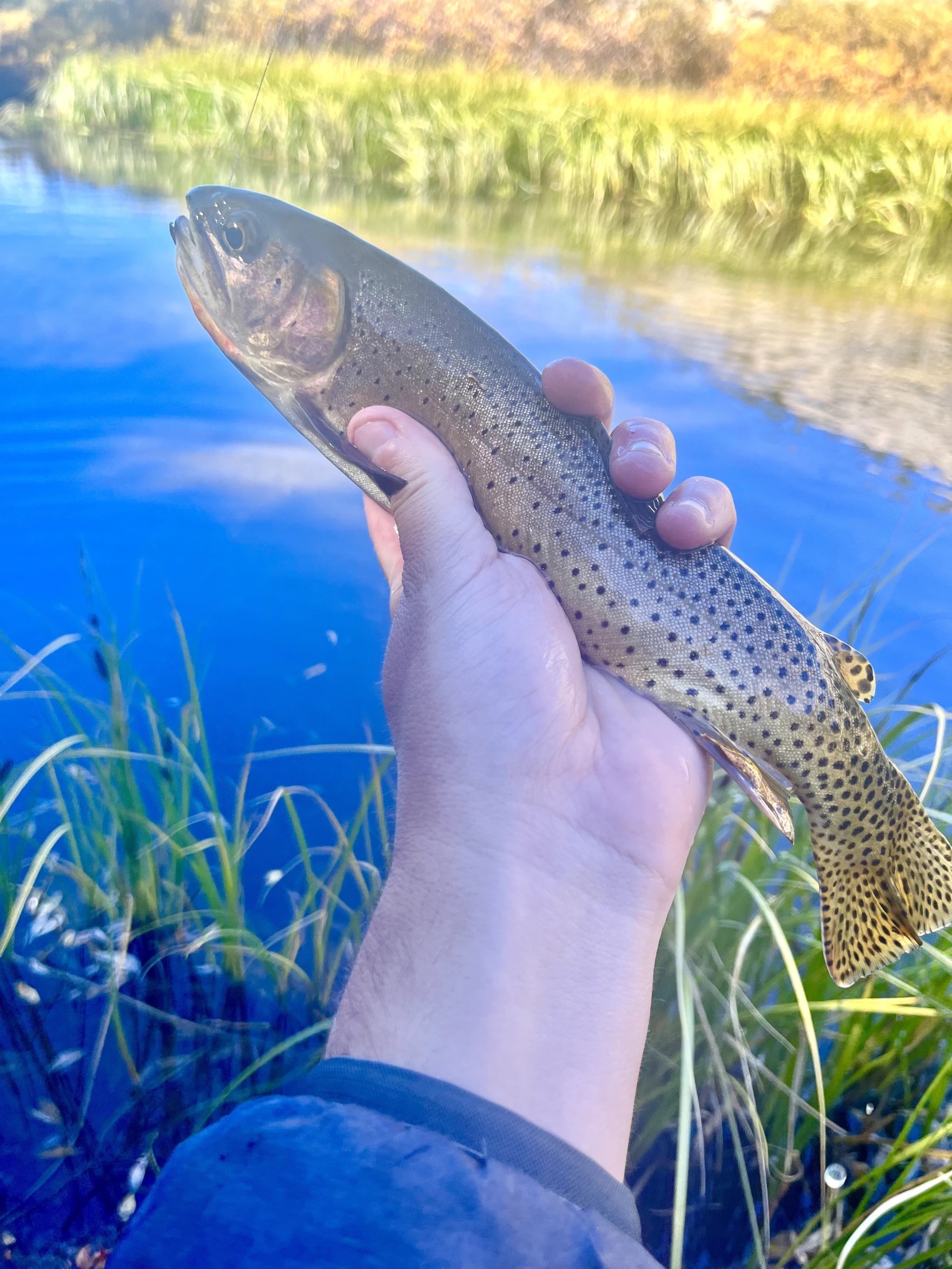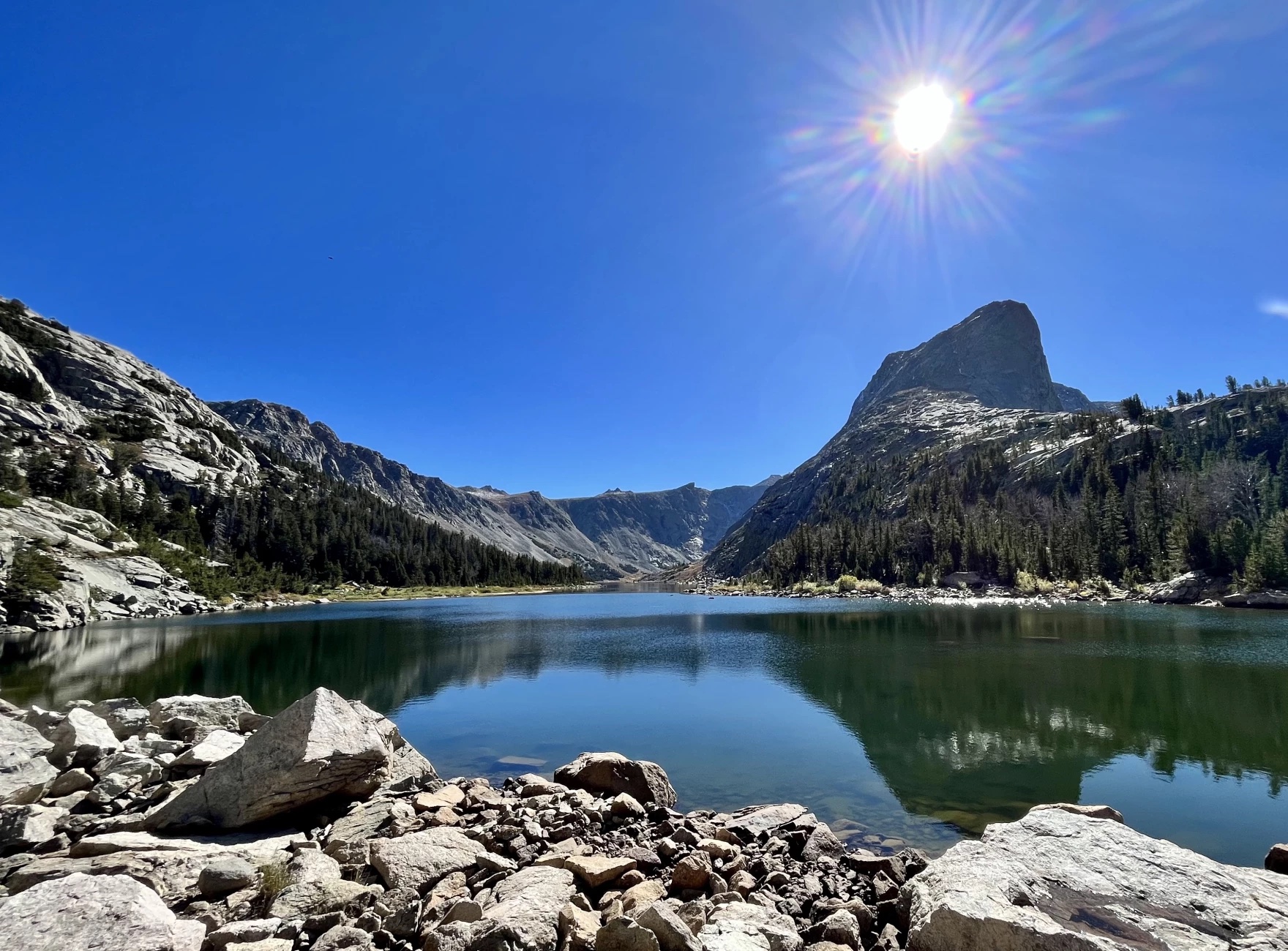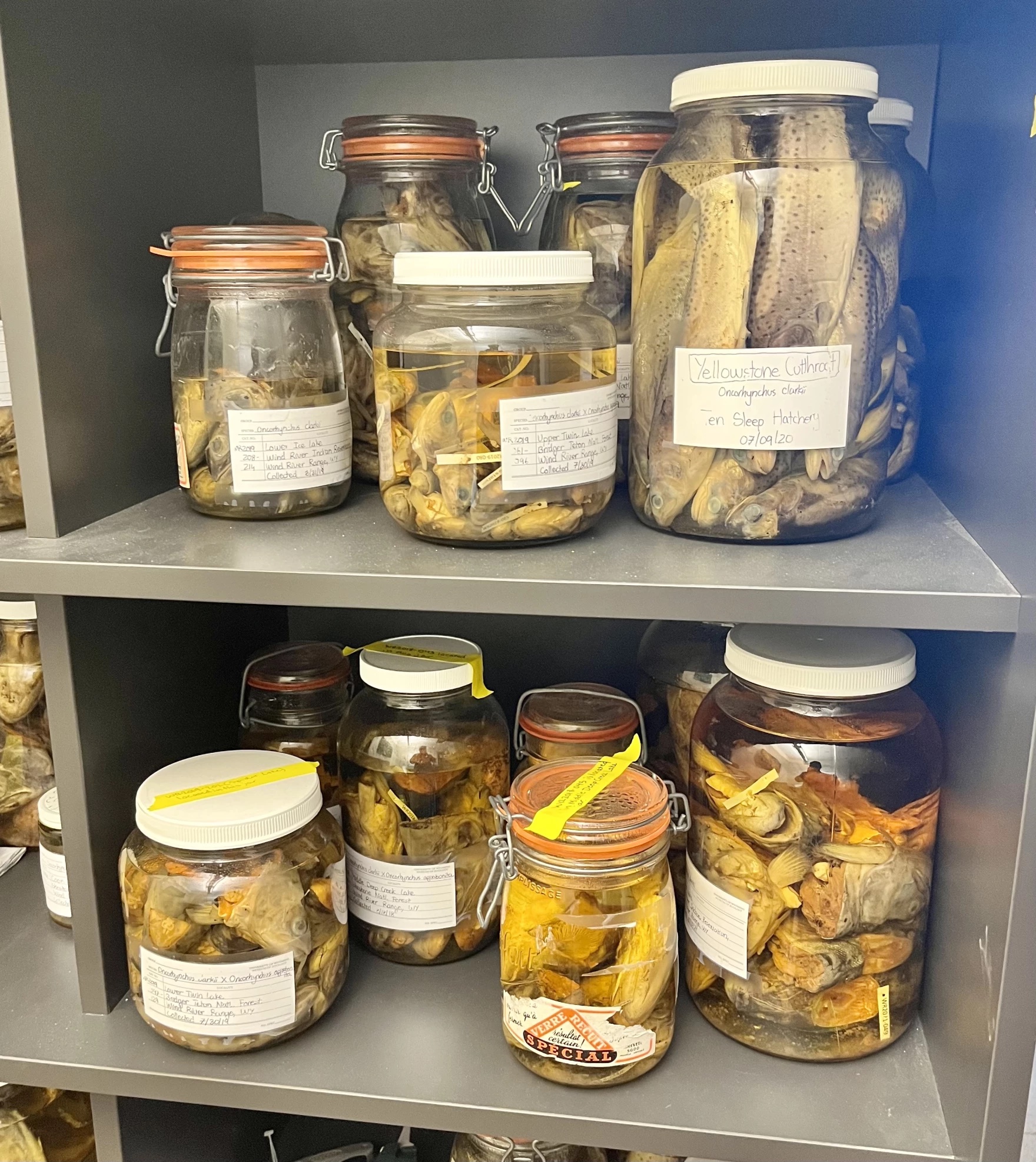In Wyoming’s Mountain Lakes, Stocked Trout Are Evolving Quickly
5:02 minutes


This article is part of The State of Science, a series featuring science stories from public radio stations across the United States. This story, by Will Walkey, was originally published by Wyoming Public Media.
Anglers across the West love to fish in high, alpine lakes, and Wyoming’s Wind River Range is nearly unbeatable for this experience. Around this time of year, frost covers the tips of trees at sunrise, and there’s plenty of room along the lonesome blue waters above 10,000 feet.
Those who do make the trek – which usually takes more than 15 miles of hiking – are greeted by hungry golden, brook or cutthroat trout looking to fatten up for the winter. They’ll take almost any fly, from a yellow foam grasshopper, to a Parachute Adams to a tiny ant. And the fish are often big, colorful and photogenic.

But as untamed, historic and relaxing as a day on the water feels, it’s anything but natural.
New research is shedding light on how the history of fish stocking has impacted alpine lake ecosystems in the Wind Rivers. In many cases, the genetics of trout have evolved rapidly, allowing them to survive in harsh mountain environments.
Starting in the 1800s, individuals, sporting clubs and government officials began stocking ponds and lakes in the Rocky Mountains with trout. Jen Brown, a university professor who wrote “Trout Culture,” a book on the subject, said many of these waterways didn’t have any fish in the first place.
“When Western settlement started occurring, settlers brought along their sport fish,” she said. “It’s a nice backcountry survival food. They’re pretty easy to catch. And they bring sport. They’ll bring people who want to go up into the mountains and then give them something to do while they’re there.”
In the first few decades, people would carry milk cans full of fish on their backs or strap them to horses. In the Wind Rivers, this was largely done by one man who ran a fishing outfit in the area. Nowadays, game and fish departments across the Mountain West usually use trucks or aircraft to dump fish into lakes.
“We think of the West and fly fishing in the West as this very pristine activity, one that is out in the wilderness and untouched by humans,” Brown said. “But in reality…those fisheries and those trout only exist through widespread manipulation of the environment.”
The manipulation of fisheries has had some consequences. Brown said that in some cases introduced trout pushed out native fish populations. Research suggests stocking has also hurt invertebrates that previously had few predators, as well as amphibians like frogs. Beginning in the 1960s, wildlife managers became more cautious with how much they impacted waters.
“And that’s actually worked really well, at least in terms of populations that are already self-sustaining,” Brown said.

But the history of stocking has still led to some interesting scientific consequences.
In a lab at the University of Wyoming, professor and evolutionary ecologist Katie Wagner has jars full of fish she helped catch with gill nets in the Wind Rivers. She’s been examining trout under a microscope to compare fish species stocked more than a century ago with hatchery fish.
Lakes in the region are usually iced over for more than half of the year, and there is very little plant life for trout to feed on. Survival is challenging in such an extreme environment.
“Having fish in these lakes is having a really big ecosystem consequence,” Wagner said. “How is that feeding back onto the fish themselves? How is that impacting their own resource? And their survival?”

What the team found—and recently published—was a case of rapid evolution. Trout developed physical attributes in their gills in just a few decades. Fish use gill rakers to filter prey such as plankton, and the more they have, the easier and more efficient it is for them to eat.
“In populations that were stocked 50 or 100 years ago, we have more gill rakers than in populations that were stocked recently or that we look at from the hatchery,” Wagner said.
This is notable because most people think evolution takes thousands or millions of years, she added. “The idea of putting fish into these really extreme and novel environments, and watching them change over the course of a human lifetime is an exciting finding.”
Researchers hope to continue to study how alpine lake fish stocking has impacted mountain environments. Wagner wants to keep looking at genetics to compare trout populations that survived in the Wind Rivers to ones that didn’t – and the differences in their environments and physical appearance.
For Lucia Combrink, lead author on the study, the research has another takeaway. In the face of declining global biodiversity, this could show that life will find a way to survive – even under extreme stress.
“It’s an example where we see rapid adaptation. And that’s hopeful for other examples where we hope that natural populations can have what they need to persist,” Combrink said. “Even in the face of major change.”
This history of ecological change – and how humans played a part in it – is a meaningful subject to think about while casting on the shores of the seemingly untouched western alpine wilderness.
Correction: This article originally referred to frogs as reptiles. They are amphibians.
Will Walkey is a reporter at Wyoming Public Media in Laramie, Wyoming.
KATHLEEN DAVIS: This is Science Friday. I’m Kathleen Davis.
SWAPNA KRISHNA: And I’m Swapna Krishna, and now it’s time to check in on the state of science.
[AUDIO PLAYBACK]
– This is KER–
– For WWNO.
– Saint Louis Public Radio.
– Iowa Public Radio News.
[END PLAYBACK]
SWAPNA KRISHNA: Local science stories of national significance– Wyoming’s Wind River Mountain range is a prime location for outdoor sports, including backcountry fishing. After some 15 miles of hiking, fishers can reach Alpine lakes and find a variety of big, beautiful trout. But these fish high up in the mountains are not a natural phenomenon. Reporter Will Walkey of Wyoming Public Media and the Mountain West News Bureau reported on the way humans have changed Wyoming’s Alpine lakes. He joins me now from Laramie, Wyoming. Welcome to Science Friday.
WILL WALKEY: Hi. Thank you for having me.
SWAPNA KRISHNA: So Will, tell me about these fish. If they aren’t natural, how did they get up into the Wind River mountains?
WILL WALKEY: Starting in the 1800s, more people are starting to move to the region, and fisherman started stocking these waters with trout. The idea was, hey, it’s good food. They’re fun to catch. And it’ll get people visiting the region and going fishing.
And so people brought fish by the millions into these lakes. They really created a fisherman’s paradise. It feels really natural when you’re out there, fishing. But it’s actually– like you said, it’s not a natural phenomenon.
SWAPNA KRISHNA: So you said it feels really natural. And you really like to fish up here, right? Set the stage for me.
WILL WALKEY: When I went out and reported this story, I got to walk about 15 miles total into this bright blue remote lake. And on the way, I passed maybe five people. You’re really out there alone with your thoughts. And I just find it like one of the most peaceful and relaxing experiences possible.
And then you find this little hole where you see fish. You put this little fly out. And then you are sitting there. And then suddenly, boom, this fish just takes it. And it’s just this moment of excitement. And yeah, now that winter is coming In Wyoming, I’m a little sad that I’m going to have to wait a few months to get to go back out into the backcountry again.
SWAPNA KRISHNA: So do we know if these fish are affecting the larger ecosystem?
WILL WALKEY: Where I went, the Wind River Range in Central Wyoming, there were no fish there when humans stocked them initially. So it did impact, for instance, some frogs, some invertebrates. But in other parts of the West, where fish were stocked, in some cases, there were other native fish there, other trout. And in some cases, those fish were kicked out of the region. Essentially, we have an invasive species situation.
And so there’s still a lot that we don’t know. But we can say, when humans do stuff like this, it tends to have big impacts. And it tends to happen quickly, as some science from the University of Wyoming found.
SWAPNA KRISHNA: So one really cool part of the story is that scientists have found that these fish are rapidly evolving. Can you tell us a little bit about that?
WILL WALKEY: Absolutely. Researchers here at the University of Wyoming went out into the backcountry of the Wind Rivers, just like I did here in Wyoming. And they studied the difference between trout that were stocked about 100 years ago versus fish that they find in hatcheries now. And they found that fish have rapidly evolved just in a couple of decades over time essentially to eat their food more efficiently.
These are really extreme waters. They are frozen over for more than half the year. There’s not a lot of food up there. They’re historically fishless, so they’re not built to support fish. To survive, they’ve had to rapidly evolve. In this case, it’s little parts of their gills that are basically evolving to eat plankton and other small bits of food more efficiently. So I talked with a University of Wyoming researcher– her name is Katie Wagner– about why this is significant.
[AUDIO PLAYBACK]
– The idea of putting fish into these really extreme and novel environments and watching them change over the course of a human lifetime is an exciting finding.
[END PLAYBACK]
WILL WALKEY: When I think of evolution, I think of it happening over thousands or even millions of years. Well, in this case, as Katie Wagner said, happened over the course of a human lifetime that we have fish that look completely different if they were stocked in the high alpine lakes of Wyoming versus something that’s grown in a hatchery. I think something that’s interesting to just think about the big picture here is humans are impacting biodiversity at sort of an unprecedented rate.
And I think what this shows is just a little bit of hope that, although humans are doing that, there are cases where fish or other animals might be able to rapidly evolve amidst humans changing the environment. And that’s exciting for me and gives me a lot of hope that life is going to be able to find a way, in the words of Jeff Goldblum, at least in some cases, even when humans put them in some pretty extreme and tough circumstances, like the high alpine lakes of Wyoming.
SWAPNA KRISHNA: Will, thank you so much for joining me.
WILL WALKEY: Thank you for having me.
Will Walkey, reporter for Wyoming Public Media and the Mountain West News Bureau based in Laramie, Wyoming.
Copyright © 2023 Science Friday Initiative. All rights reserved. Science Friday transcripts are produced on a tight deadline by 3Play Media. Fidelity to the original aired/published audio or video file might vary, and text might be updated or amended in the future. For the authoritative record of Science Friday’s programming, please visit the original aired/published recording. For terms of use and more information, visit our policies pages at http://www.sciencefriday.com/about/policies/
Kathleen Davis is a producer and fill-in host at Science Friday, which means she spends her weeks researching, writing, editing, and sometimes talking into a microphone. She’s always eager to talk about freshwater lakes and Coney Island diners.
Rasha Aridi is a producer for Science Friday and the inaugural Outrider/Burroughs Wellcome Fund Fellow. She loves stories about weird critters, science adventures, and the intersection of science and history.
Swapna Krishna is a journalist based in Philadelphia, Pennsylvania.